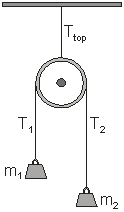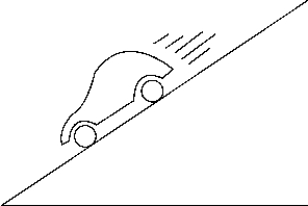A) the magnitude of ![]() only.
only.
B) MA and MB only.
C) the magnitudes of ![]() , MA, and MB only.
, MA, and MB only.
D) the ratio of MA to MB only.
E) MA, MB, and the weights of MA and MB.
G) A) and E)
Correct Answer

verified
Correct Answer
verified
Multiple Choice
A body of weight w rests on the surface of Earth. What force does the body exert on Earth? Ignore Earth's rotation.)
A) w
B) greater than w
C) less than w
D) 9.81w
E) zero
G) A) and E)
Correct Answer

verified
Correct Answer
verified
Multiple Choice
 A frictionless pulley of negligible mass is hung from the ceiling using a rope, also of negligible mass. Two masses, m1 and m2 m1 < m2) are connected to the rope over the pulley. The masses are free to drop. The magnitude of the tension Ttop is ____ the sum of the tensions T1 and T2.
A frictionless pulley of negligible mass is hung from the ceiling using a rope, also of negligible mass. Two masses, m1 and m2 m1 < m2) are connected to the rope over the pulley. The masses are free to drop. The magnitude of the tension Ttop is ____ the sum of the tensions T1 and T2.
A) less than
B) equal to
C) greater than
D) not related to
E) dependent on Ttop
G) A) and E)
Correct Answer

verified
Correct Answer
verified
Multiple Choice
Three blocks are connected by massless cords and hung by a third massless cord to a beam. Mass m1 = 2 m2 = 3 m3. Mass m1 is the lowest block and m3 is the highest. The tension in the cord between the two highest blocks is
A) 3m1 * g/2.
B) m1 * g/2.
C) m1 * g/6.
D) 2m1 *g/3.
E) 6m1 * g/11.
G) D) and E)
Correct Answer

verified
Correct Answer
verified
Multiple Choice
A body moves with constant speed in a straight line. Which of the following statements must be true?
A) No force acts on the body.
B) A single constant force acts on the body in the direction of motion.
C) A single constant force acts on the body in the direction opposite to the motion.
D) A net force of zero acts on the body.
E) A constant net force acts on the body in the direction of motion.
G) C) and E)
Correct Answer

verified
Correct Answer
verified
Multiple Choice
A 100-kg man on ice skates pushes a 25-kg boy, also on skates, with a force of 250 N. As a result,
A) both the man and the boy will have an acceleration of magnitude 2 m/s2.
B) only the boy will have an acceleration of magnitude 2 m/s2.
C) only the man will have an acceleration of magnitude 10 m/s2.
D) the man will have an acceleration of magnitude 2.5 m/s2.
E) the heavier man will be stationary.
G) B) and C)
Correct Answer

verified
Correct Answer
verified
Multiple Choice
A particle with a mass of 200 g is acted on by a net force of 4.5 N. The acceleration of the particle is
A) 90 cm/s2.
B) 2.3 cm/s2.
C) 0.90 km/s2.
D) 23 m/s2.
E) 9.0 m/s2.
G) None of the above
Correct Answer

verified
Correct Answer
verified
Multiple Choice
Which of the following is not a unit of mass?
A) pound
B) kilogram
C) gram
D) slug
E) milligram
G) A) and E)
Correct Answer

verified
Correct Answer
verified
Multiple Choice
Newton's law of inertia does not describe the behavior of objects that are
A) in inertial frames of reference.
B) moving with constant velocity relative to a given frame of reference.
C) at rest relative to a given frame of reference.
D) moving in accelerated frames of reference.
E) moving in a straight line at constant speed relative to a given reference frame.
G) C) and D)
Correct Answer

verified
Correct Answer
verified
Multiple Choice
Your heart pumps 80 g of blood with each beat. The blood starts from rest and reaches a speed of 0.60 m/s in the aorta. If each beat takes 0.16 s, the average force exerted on the blood is
A) 3.0 * 102 N.
B) 0.22 N.
C) 0.16 N.
D) 0.30 N.
E) 0.98 N.
G) B) and D)
Correct Answer

verified
Correct Answer
verified
Multiple Choice
The diagrams below show the application of an external force F on a block of mass m resting on a horizontal surface.  In which diagrams) does the block experience the largest normal force?
In which diagrams) does the block experience the largest normal force?
A) Both 1) and 3)
B) Only 1)
C) Only 2)
D) Only 3)
E) Only 4)
G) B) and D)
Correct Answer

verified
Correct Answer
verified
Multiple Choice
A horse harnessed to a wagon refuses to pull, citing Newton's third law, which states that for every force there is an equal but opposite reaction force. The horse, incorrect in its reasoning, can pull the wagon because
A) after it gives a jerk and the wagon is moving, its pulling force will be greater than the reaction to this force.
B) the law applies only to static cases.
C) the wagon cannot possibly pull back with a force equal in magnitude to the pulling force.
D) the action and reaction forces are acting on different bodies.
E) after friction is overcome, the reaction force is less than the pulling force.
G) B) and E)
Correct Answer

verified
Correct Answer
verified
Multiple Choice
A force accelerates a body of mass M. A second body requires twice as much force to produce the same acceleration. What is the mass of the second body?
A) M
B) 2M
C) M/2
D) 4M
E) M/4
G) All of the above
Correct Answer

verified
Correct Answer
verified
Multiple Choice
Which of the following statements is true?
A) The mass of a body is a quantitative measure of its inertia.
B) Mass is a vector quantity.
C) The mass of a body is directly proportional to the acceleration it is experiencing.
D) The unit of mass in the U.S. customary system is the newton.
E) The mass of a body is inversely proportional to the resultant force acting on it.
G) A) and B)
Correct Answer

verified
Correct Answer
verified
Multiple Choice
We all know it makes sense to bend one's knees when dropping from a height.Suppose a very silly 70-kg person were instead to drop down from a height of 1.4 m onto the ground and stop stiffly within a distance of only 0.60 cm. Calculate how many times his own weight is the average force his body feels.
A) 15
B) 24
C) 2.3 * 103
D) 6.1 *102
E) 2.3 *102
G) A) and B)
Correct Answer

verified
Correct Answer
verified
Multiple Choice
An inertial reference frame is one in which
A) Newton's first law describes the behavior of matter.
B) the law of inertia is not applicable.
C) there is a great deal of matter.
D) the object of interest is traveling in a circular path.
E) forces do not necessarily exist in pairs.
G) D) and E)
Correct Answer

verified
Correct Answer
verified
Multiple Choice
A ball of mass 2.0 kg is acted on by two forces,  and
and  . The magnitude of the acceleration is
. The magnitude of the acceleration is
A) 2.5 m/s2.
B) 3.9 m/s2.
C) 4.6 m/s2.
D) 5.1 m/s2.
E) 5.8 m/s2.
G) B) and C)
Correct Answer

verified
Correct Answer
verified
Multiple Choice
A mass of 25 kg is acted on by two forces, one of which is 15 N due east while the second one is 10 N due north. The acceleration of the mass is
A) 0.72 m/ s2, 56.3o north of east.
B) 0.20 m/ s2, due east.
C) 0.72 m/ s2, 33.7 o north of east.
D) 1.0 m/ s2, 33.7 o north of east.
E) 0.20 m/ s2, 56.3 o north of east.
G) A) and E)
Correct Answer

verified
Correct Answer
verified
Multiple Choice
 Which of the following free-body diagrams represents the car going downhill without acceleration?
Which of the following free-body diagrams represents the car going downhill without acceleration? 
A) 1)
B) 2)
C) 3)
D) 4)
E) 5)
G) A) and D)
Correct Answer

verified
Correct Answer
verified
Multiple Choice
What is the weight of a 50-kg boy on the Moon, where the acceleration due to gravity is 1.6 m/s2?
A) 80 N
B) 100 N
C) 490 N
D) 50 N
E) 80 lbs
G) B) and E)
Correct Answer

verified
Correct Answer
verified
Showing 41 - 60 of 93
Related Exams